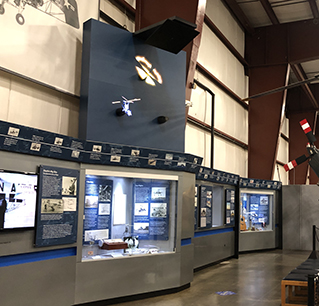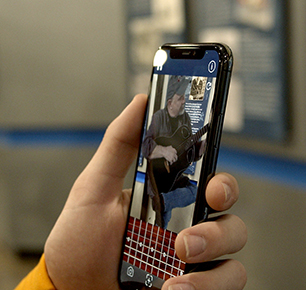Museum Design Trends: Story of Collaboration – New England Air Museum and Quast Media
By Richard Conti, Director of Business Development, Quast Media LLC, Nick Hurley, Curator, New England Air Museum; Edited by Sarah Laroche, Content Creator | Quast Media LLC
Digital technology applications have been popping up in more diverse ways across a multitude of industries, making them more accessible and easier to implement.
This has worked to the advantage of the museum and exhibition industry, as over the last several years, museums have focused on finding new and efficient ways to enhance their visitors' experience, often within the confines of finite budget and available space.
With changes in visitor demographics, experience expectations, and the implementation of technology, as well as the funding necessary to implement it, museums are looking to digital interpretive design to modernize and increase accessibility to attract and engage visitors.
It all starts with understanding the visitor and then targeting specific applications and approaches to meet the needs of their clientele. For example, younger audiences are now becoming a large percentage of visitors; they expect a modern, technological experience that matches how they use technology in their day-to-day activities. A poorly designed website or app could deter younger generations as they have certain expectations regarding their digital experiences. Not meeting those specified qualifications is what can lead younger visitors to avoid museums in favor of more modern attractions.
On the other hand, the older generation of museumgoers often favors a more conventional, direct, and low-key encounter. Many of these individuals may not have the skills necessary to take advantage of newer, technologically based exhibits. It is imperative to balance the approach to technology with ease of access to reach this population of potential visitors.
When it comes to accessibility, ensuring that those with various disabilities can experience an exhibit on par with their peers is crucial. Designing technology with this in mind includes considering the placement of kiosks, buttons, and any interactive elements.
The economics of transformative improvements like technology are an important consideration. As costs rise and competition grows from concert, theater, and sports venues, museums must craft an experience featuring higher entertainment value. Families are faced with tighter budgets, so they want the most for their money. When museums utilize their available space efficiently, which is a formula technology tends to play into, they can offer more without the need to expand or incur construction costs.
As a digital marketing and technology agency, Quast Media has played a significant part in this technology evolution in several museum projects, garnering firsthand experience and insight on the best approaches, including the usage of both passive and active digital experiences within exhibits.
Quast Media recently completed a project for the New England Air Museum, a NEMA member museum located in Windsor Locks, CT. For this project, both active and passive digital experiences were implemented into the experience. Tasked with developing innovative ways to enhance the “KAMAN: A Legacy of Innovation” exhibit, Quast Media collaborated with the New England Air Museum staff and management to find ways to boost the interpretive value of an existing exhibit without materially changing the footprint.

Nick Hurley, the Curator at NEAM, explains the challenges and outcomes the museum was looking for: How do you tell a complex story with a limited amount of exhibit space?
This was the challenge we at the New England Air Museum (NEAM) faced when the time came to upgrade our exhibit on the Kaman Corporation, an aerospace company headquartered in Bloomfield, Connecticut. In addition to providing visitors with an in-depth look at the company’s history and technological achievements, Kaman: A Legacy of Innovation also tells the life story of the company’s founder, aeronautical engineer, and inventor Charles Kaman.
Even in its original form, this exhibit did a good job of accomplishing both objectives through graphic imagery, videos, and objects (including three original Kaman helicopters expertly restored by NEAM volunteers). That said, there was so much of the overall story that didn’t make it into the final product. This was due to concerns over inundating visitors with too much text and imagery within the exhibit’s limited footprint.
Though it began as an aerospace company, Kaman expanded its reach into the field of music in the mid-1960s. Utilizing their knowledge of composite materials gained in the aviation industry, they designed and produced the Ovation guitar, a round-backed instrument that generates a uniquely resonant sound. We had one of these guitars on display in the exhibit, but there was little interpretation beyond a description of the artifact. Moreover, while we could describe the sound the guitar would make, visitors couldn’t hear it for themselves.
There were also some technical subjects that we found difficult to explain to visitors through text or simple graphics. The servo-flap, a method of controlling the pitch of a rotor blade in flight to reduce vibration and improve stability, was a feature incorporated into many of Charles Kaman’s helicopter designs, as was the unique “egg-beater” style of intermeshing rotor blades. Both concepts were central to the company’s early success and development, and were represented in the original exhibit, but needed more context and visualization for visitors to understand exactly how these design features worked.
Interactive digital technology proved to be an ideal way to ensure these, and other aspects of the Kaman story could be highlighted and explained in a way that made the information attractive and accessible to a wide audience. In addition, adding these digital experiences could be done in a way that did not require a complete renovation, rebuild, or expansion of the existing exhibit. The “depth” of knowledge was increased without adding more text for visitors to read or videos for them to sit through.
THE SOLUTION
Thanks to generous financial support from the Kaman Foundation, NEAM was able to partner with Quast Media to design and install several active and passive digital experiences for the exhibit in 2020. The theories behind intermeshing rotor blades and the servo-flap technology are now explained via holographic imaging showing both concepts in operation, projected above the exhibit for all to see and accompanied by custom 3D images and a narrative audio track. Elsewhere, a freestanding touch-screen kiosk allows users to learn more about Charles Kaman’s life and achievements or assemble their own K-MAX helicopter via a drag-and-drop gamified experience. Through an augmented reality (AR) scavenger hunt played on their phone, visitors can listen to a seasoned musician strum his Ovation guitar or “fly” their own balsa wood glider (a virtual reproduction of one built by Charles as a boy).
Just as a “non-digital” exhibit seeks to attract the attention of a wide variety of museumgoers, these enhancements were carefully crafted with accessibility and appeal in mind. While some less tech-savvy visitors may shy away from downloading the NEAM app and trying the AR scavenger hunt, they may enjoy the experiences offered by the kiosk, which are available by simply tapping the screen, or the holographic projection, which requires no input at all on the part of the visitor; simply sit back, watch, and enjoy!

This project marked our first major foray into using digital technologies in our exhibits, and its success served as a benchmark for similar endeavors we’ve undertaken since then. Moreover, it showed us that we didn’t need extensive, in-depth technical knowledge to incorporate this kind of technology into the museum experience, especially when partnered with a reliable vendor like Quast Media who provided guidance on everything from the layout of the graphic user interface (for both the AR scavenger hunt and the kiosk) to the minor facilities updates we needed to complete to ensure the new hardware had sufficient power and network connections.
Perhaps the reason these upgrades to Kaman: A Legacy of Innovation were so well received is because they made an already great exhibit even better. The new digital experiences complemented the existing imagery, text, objects, and video to create a more immersive experience and—most importantly—offer one more way for visitors to engage with the information being presented. This mixing of old and new means of storytelling is an ideal approach for NEAM, a museum that preserves not just the history of aviation, but the history of the technology that made it possible.
For more information about the New England Air Museum's enhanced KAMAN exhibit, visit https://www.quastmedia.com/museum-case-study (used with permission of NEAM).
Quast Media would also like to thank ARSOME Technology of Manchester, CT, who we employed as a third-party resource to provide programming and execution to meet project deadlines.
Since the completion of the KAMAN exhibit enhancement, the museum and Quast Media have completed two further exhibit enhancements (New England Women in Aviation, and The Kosciuszko Squadron) and have a fourth planned to begin in the Fall.
The technology applications used in the KAMAN exhibit are just a few examples of how digital technologies can benefit, enhance, and support museum exhibits while appealing to a widening demographic of museum visitors. Many additional digital experiences are now gaining attention and traction. These include “projection-on-glass,” “projection mapping,” “VR museum spaces,” 360-degree virtual tours, and downloadable apps that allow for more interaction between the digital and physical spaces.
Design considerations for digital technology usage comprise several factors including the museum's brand and current marketing strategy, the facility's architecture, and the scope of technological integration to meet the museum's objectives. In other words, technology for technology's sake is not always the best choice. Quast Media believes it is necessary to fully evaluate a digital experience on several levels before considering deployment.
As digital technologies become more prevalent and more diverse engagement methods surface, staying current is paramount. Planning for the future is essential for museums so that they may grow and offer relevant, informative, and exciting ways to showcase their collections. These exhibits must be easily experienced by a wide demographic.
One thing seems certain: Digital technologies will continue to be at the forefront of creating new, valuable interpretive experiences that will delight, inspire, and motivate museum visitors, both now and in the future.
-----------------
About Quast Media
Quast Media LLC is a digital marketing and technology company located in Manchester, CT, and Nashville, TN. They are proud members of the New England Museum Association.
Their work applies the power of brand communication and customized cutting-edge technology solutions such as digital signage, hi-resolution and 360-degree video production, augmented and virtual reality (AR/VR), and 3D holographic projection. Quast Media seeks to help clients engage, interact with, and entertain audiences through a unique digital experience. Using years of experience, they create and execute customized solutions that reflect each client's needs and objectives. By working with a command of leading-edge digital media technologies and skill sets, Quast Media's mission is to create experiences that educate, connect, and move people in powerful ways.
--------------------
About The New England Air Museum
The New England Air Museum is the largest aviation museum in New England. The year 2020 marked the 60th anniversary of the Connecticut Aeronautical Historical Association, the parent organization of the New England Air Museum. The NEAM: 60 Years, 60 Stories project celebrates this important milestone by chronicling the museum's history through the stories of current and former museum volunteers and employees as well as institutional records. Tales of aircraft restorations, open cockpits, and even a rogue tornado; can be found within this multimedia exhibit. Featuring many stories containing testimonials from some of the men and women whose hard work and dedication helped make the New England Air Museum the organization it is today.